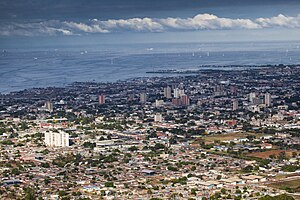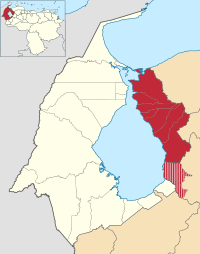Transport in Venezuela revolves around a system of highways and airports. Venezuela is connected to the world primarily via air and sea. In the south and east the Amazon rainforest region has limited cross-border transport; in the west, there is a mountainous border of over 1,375 miles (2,213 km) shared with Colombia. The Orinoco River is navigable by oceangoing vessels up to 400 km inland, and connects the major industrial city of Ciudad Guayana to the Atlantic Ocean.
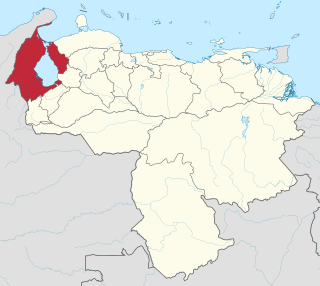
Zulia State is one of the 23 states of Venezuela. The state capital is Maracaibo. As of the 2011 census, it has a population of 3,704,404, the largest population among Venezuela's states. It is also one of the few states in Venezuela in which voseo is widespread. The state is coterminous with the eponymous region of Zulia.

Maracaibo is a city and municipality in northwestern Venezuela, on the western shore of the strait that connects Lake Maracaibo to the Gulf of Venezuela. It is the second-largest city in Venezuela, after the national capital, Caracas, and the capital of the state of Zulia. The population of the city is approximately 2,658,355 with the metropolitan area estimated at 5,278,448 as of 2010. Maracaibo is nicknamed "The Beloved Land of the Sun".
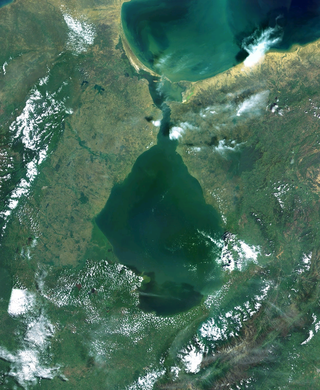
Lake Maracaibo is a brackish lagoon located in northwestern Venezuela, between the states of Zulia, Trujillo, and Mérida. Hydrologically, it is a semi-enclosed bay off the coast of the Gulf of Venezuela. The lagoon is commonly considered a lake, though due to its current geological characteristics, it should not be considered as such. With a surface area of 13,512 km2 (5,217 sq mi), it is the largest lake in South America and one of the oldest on Earth, having formed undisputably as a lake 36 million years ago in the Andes Mountains.

The State of Mérida commonly known simply as Mérida is one of the 23 states of Venezuela. The state capital is Mérida, in the Libertador Municipality.

The Archdiocese of Maracaibo is an archdiocese in Venezuela. Since November 2000, its Archbishop has been Ubaldo Ramón Santana Sequera. The city of Maracaibo, the second largest in Venezuela, has a population of approximately 2,800,000. The Archdiocese covers a total area of 10,761 square kilometers in Zulia State.

Municipalities of Venezuela are subdivisions of the States of Venezuela. There are 335 municipalities dividing the 23 states and the Capital District.
Cabimas is a city on the shore of Maracaibo Lake in Zulia State in northwestern Venezuela. In 2005, its population was around 200,859.
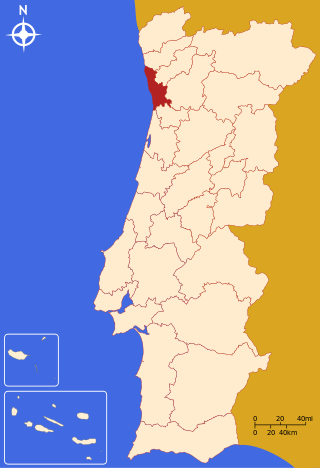
Grande Porto or Greater Porto is a former Portuguese NUTS3 subregion, integrating the NUTS2 region of Norte, in Portugal. It was abolished at the January 2015 NUTS 3 revision.

The State Railways Institution is a state-run organization of Venezuela that manages the railway systems of the country. Its headquarters are located in Caracas, Venezuela.

Guaicaipuro is one of the 21 municipalities (municipios) that makes up the Venezuelan state of Miranda and, according to a 2007 population estimate by the National Institute of Statistics of Venezuela, the municipality has a population of 280,687. The town of Los Teques is the municipal seat of the Guaicaipuro Municipality. The municipality is named for the sixteenth century cacique Guaicaipuro.

Urdaneta is one of the nine municipalities (municipios) that make up the Venezuelan state of Lara and, according to a 2007 population estimate by the National Institute of Statistics of Venezuela, the municipality has a population of 63,213. The town of Siquisique is the municipal seat of the Urdaneta Municipality. The municipality is one of several in Venezuela named "Urdaneta Municipality" in honour of Venezuelan independence hero Rafael Urdaneta.
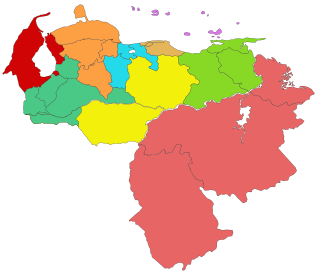
The Zulian Region is one of the 10 administrative regions into which Venezuela is divided for its development plans. This region is coterminous with Zulia State and is administrated by CORPOZULIA. The people from this region seek autonomy from the central government.

Ciudad Ojeda is a city located in the northeastern shore of Lake Maracaibo in Zulia State in northwestern Venezuela. Its population as of the 2005 census was listed as 128,941.
Falcón Zulia State was a state of Venezuela created by initiative of president Antonio Guzmán Blanco.

Sur del Lago de Maracaibo is a subregion comprising the territory of the municipalities Jesús María Semprún, Catatumbo, Colón, Francisco Javier Pulgar and Sucre from Zulia state and the municipality Alberto Adriani, Obispo Ramos Lora and the population of Palmarito from Tulio Febres Cordero municipality from the state of Mérida, Venezuela. Its major towns are Santa Barbara del Zulia, San Carlos del Zulia and El Vigia, which represents its economic epicenter.
An energy collapse in the state of Zulia, Venezuela occurred as a result of the country's ongoing general crisis, and it is the largest of its kind in the history of the state. With previous events in 2015 and 2016, the collapse intensified in 2017, when in September an alleged theft of cables left the city of Maracaibo and its surroundings without electricity. Since then long and short-term blackouts have been reported, which also cause the suspension of water supply, failures in cable television, telephone coverage and Internet access, among other services, as well as difficulty conducting business transactions, caused by the scarcity of banknotes and the dependence on the large-scale use of the point of sale terminals as well as electronic payments that are deficient in the absence of electricity and the Internet, resulting in closing of establishments, absence of work, damage of food and electrical appliances, the decrease in quality of life, among other factors, which added to the high temperatures suffered by citizens, affect the normal development of the population. Authorities such as the national government and the government of Zulia have attributed these failures to an alleged sabotage, but the opposition and experts denounce that it is due to lack of maintenance, also arguing that only less than half of what is consumed regularly is produced, reason for which there is "cargo administration" (rationing). The National Assembly of Venezuela, of opposition majority, declared the region in a state of electrical emergency. The service has also been interrupted but to a lesser extent in other states such as Bolívar, Carabobo, Falcón, Mérida, Miranda, Nueva Esparta, Táchira, Vargas and the country's capital Caracas.

San Francisco is a municipality in the metropolitan area of Maracaibo, Venezuela's second largest city. San Francisco covers an area of 185 square kilometres (71 sq mi) and recorded a population of 446,757 in the 2011 Venezuelan census.
Mariángel Villasmil Arteaga is a Venezuelan model and beauty pageant titleholder who was crowned Miss Venezuela 2020. She represented the state of Zulia at the pageant and represent Venezuela at the Miss Universe 2020 competition.
